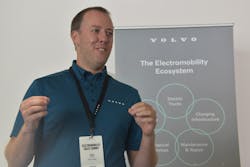As early as March 2019, a leading trucking-industry tester of new sustainable technology, the North American Council for Freight Efficiency (NACFE), was reporting that charging and the infrastructure needed to support it would be among the highest mountains for commercial carriers to climb toward meaningful adoption of commercial battery-electric vehicles.
Volvo Trucks North America—a sponsor and demonstrator of the possibilities of electrification in trucking long before the company went into production last year with its regional VNR Electric—seems to have been listening. But the OEM is blazing paths of its own in its sustainability mission to establish a foothold in America for all-electric freight transportation technology.
See also: For those skeptical of EVs, Volvo offers ‘electromobility ecosystem’
VTNA has made charging and infrastructure support for customers of the Class 8 VNR Electric a key component of its “electromobility ecosystem,” which it highlighted Sept. 29 at an Electromobility Summit at the U.S. subsidiary’s customer center in Dublin, Virginia, adjacent to the New River Valley truck assembly plant that builds and tests the VNR Electric.
“We know that charging is complex, and there are many, many questions for which we need to come up with solutions,” said Manuel Aguirre, Volvo’s head of charging and infrastructure solutions for North America, who helped lead a summit session on the OEM’s charging and infrastructure solutions. “As we switched to e-mobility, we realized that we needed to take care of every step along the way.”
Dan Freeze, charging solutions product manager at Volvo Energy, which is the OEM’s newest business area and dedicated to accelerating electrification for its customers, also helped lead the summit session.
Freeze, a self-described “early adopter” of an electric Nissan Leaf, related a story about a short road trip in bad weather he took with his wife and 6-month-old child in his personal electric vehicle that did not go well because along the way they could not find reliable charging to ensure their journey was smoother.
“I was very confident; I thought I had all the answers that I needed,” he said. “If I had somebody to help me through that transition to start … that’s why we’re here, that’s our mission here today.”
"We're here to make sure customers can get from points A to B to C. It's all part of this ecosystem," Aguirre added. "It's more than just the truck. We're here to help every step of the way. How are you going to handle charging? Is it going to be along the way, or is it going to be overnight charging? Maintenance, is the charger working? Efficiency and uptime are very very important."
Public vs. terminal-based charging
Any commercial freight carrier exploring electrification must answer this basic question: Where will my EVs charge?
One choice for electric adopters, company depot or terminal charging, is much more realistic now—if the initial costs can be overcome—than is pulling up to a public facility along a freight route to power back up. Public charging for commercial vehicles is years away from being widely available, though there are state and federal efforts at building these networks. VTNA is beginning one of its own.
In terms of “home” depot charging, Volvo has built that into its “ecosystem” as a seven-pronged program: advisory services, the charging hardware itself, turnkey installation, charging management software, maintenance and uptime, management of the many public incentives available (most widely in California so far) to finance the chargers and the related infrastructure to connect to an area’s electrical grid or to a company’s microgrid, and financing packages to pay for the parts of the charging infrastructure that public incentives will not cover.
See also: Volvo to sell VNR Electric chargers directly to customers
An eighth prong of that strategy is Volvo’s U.S. partnerships to develop public charging locations. For that, Volvo is sponsoring a public-charging pilot program, based out of its EV-certified dealerships in California and currently connected by seven sites, all equipped with two 180 kW type-CCS1 chargers, across the Central Valley there. Generally, 75 kW to 250-plus kW fast chargers take two to seven hours to bring commercial trucks to full charge. Smaller “slow” but less expensive chargers up to 50 kW, often the portable variety like the Heliox Fast DC 50 displayed at the Sept. 29 summit, take six to 12 hours to "fill" an EV. Both are available to finance through Volvo for any customer of its VNR Electric, which comes in several configurations, a 4x2 straight truck, a 6x4 straight truck, a 4x2 tractor, a 6x2 tractor, or a 6x4 tractor.
The pilot charging network will be open to any commercial electric vehicle, regardless of its maker, meaning a driver does not need to be operating a Volvo commercial model to queue up and charge. The OEM sees the “charging corridor”—a partnership with Shell and EV-certified VTNA dealerships Affinity, Western, and TEC Equipment—as a template for future expansion. The pilot benefits from $2 million in funding from the California Energy Commission.
OEM dives deep into helping customers navigate charging challenges
Volvo has a growing list of “installation partners,” including Gilbarco Veeder-Root, Heliox, InCharge, ABB, Burns-McDonnell, ABM Industries, Schneider Electric and Black & Veatch, to help customers navigate the permitting, interaction with local electric utilities, and installation of charging infrastructure, including pre-negotiated pricing, said Volvo Energy’s Freeze.
The OEM has positioned itself as a conduit to incentives that it tells customers can lower total cost of ownership.
The purchase price of a Class 8 EV can be twice as much or more as its diesel-burning counterpart, so funding is available nationally and in California to close the cost disparity. VW settlement funding nationally and the HVIP, Prop 1-B, and the Carl Moyer Memorial Air Quality Standards Attainment Program in California.
The incentives can cut the cost of a heavy truck like the VNR Electric by $60,000 to $200,000. And Volvo has leasing options for its Class 8 regional EV.
What about incentives for charging and infrastructure?
Through Volvo, they are robust as well, from public utilities and through federal and state incentives such as EnergIIZE, the Infrastructure Investment and Jobs Act, and other competitive grants.
These can add up to provide no “to-the-meter” installation costs and up to 50% rebates on the cost of charging hardware and infrastructure, according to information provided by Volvo officials at the summit. The OEM can also plug customers into carbon credits through Low Carbon Fuel Standard program in California and others available in states such as Washington and Oregon.







